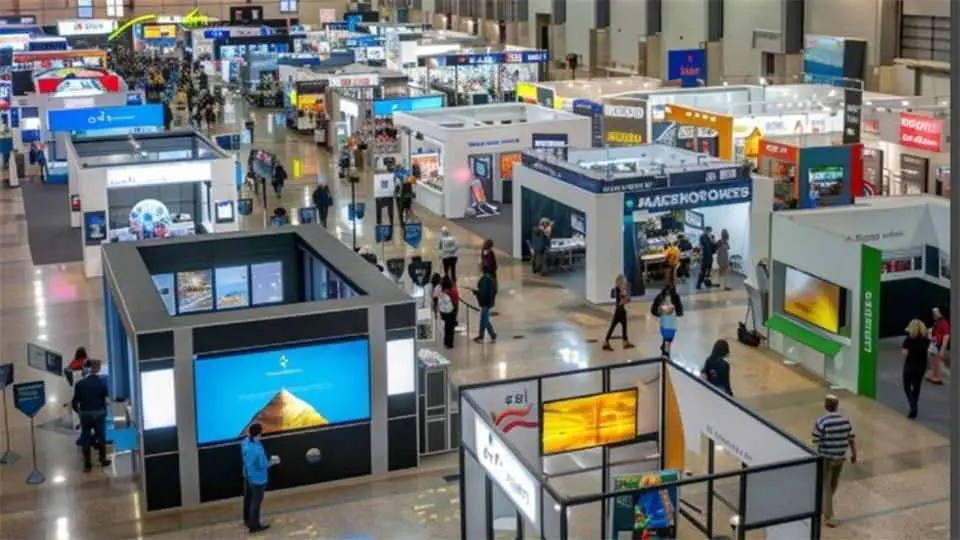Trade shows are among the top venues for brands to engage potential buyers, partners, and investors. The problem is not just attending the trade show but developing an exhibit that attracts, engages, and converts.
An exhibit experience is more than a space—it is a communication medium that can intrigue, speak to, and suggest professionalism, creativity, and intention. Proper design—custom, used trade show booth—can actually influence foot traffic flow, leading to increased brand recall and potentially maximizing return on investment (ROI).
Smart Design Strategies That Transform Exhibits into Profit-Driven Assets

- Design with Purpose: Visual Consistency in Custom Trade Show Booths
The groundwork for a strong trade show presence starts with clarity of design and message alignment. Branded merchandise and custom exhibits for trade shows must communicate a continuous visual identity—colors, logos, typefaces, and images should all work together in harmony.
This authenticity reinforces brands, making identification and recollection easier for attendees even long after the event is over. When an organization uses visuals in alignment with the brand’s personality to do more than decorate, they become communicative.
The layout, illumination, and arrangement of products communicate how visitors move throughout the space; a balance must be sought between an artful appearance and more traditional functionality.
Furthermore, when visuals highlight the journey and mission, it invites more meaning to the experience. Better engagement and conversions result from maintaining consistency across all designs, which also conveys professionalism and builds trust.
- Optimize Space for Flow and Functionality
When exhibiting, every inch of booth space matters. To maximize comfort for guests to explore, an effective traffic flow will help them engage with important displays and demonstrations. An overly packed layout can deter potential customers, while a thoughtful layout will encourage more lingering.
Positioning your interactive stations first so guests can use the back wall for deeper conversations and seating.
Modular designs that can be configured in multiple ways are desirable for businesses that attend multiple events, as they can adapt the layout to the final venue dimensions without sacrificing design. Functionality can also include storage, digital kiosks, and talk areas that will promote meaningful conversations while containing the crowd.
- Incorporate Technology to Elevate Engagement
Technology has become a standard feature in trade show presentations of the present. Touch screens, projection mapping, and fully immersive virtual reality experiences are tools that create an opportunity for engagement and all sorts of storytelling to occur.
These technological attributes allow attendees to engage and experience a product or service in ways that cannot happen with static content. For example, a digital screen can showcase a live social media feed, customer testimonials, or even short promotional clips that show customer satisfaction and brand success.
Augmented Reality (AR) applications provide a chance to engage with the product without requiring a lot of physical products to be displayed. Technology is an innovative way to attract attention and provide analytics on attendee engagement, providing primary data to inform decision-making after the event.
- Focus on Lighting and Sensory Appeal
Lighting, a crucial yet sometimes disregarded aspect of booth effectiveness, is used to define areas, highlight important products, and create an environment congruent with the preferred interaction. Soft ambient light may create an inviting space, whereas task lighting may emphasize a hero product or main highlight.
Conversely, an excessively bright light in an inappropriate location may lead to visual fatigue or alter the color of products. As a key experience, sensory experience should not be overlooked. Background music, light scent, and tactile samples of products are all sensory opportunities to engage multiple senses while creating an impression for visitors.
A booth, particularly when sensory experience is included, will be more prone to longer visits and meaningful conversations. An emotionally affecting experience will lead to a brand that is remembered long after the show.
- Measure, Refine, and Reinvest for Better ROI
Maximizing your return on investment does not end when the event is over. Gathering and evaluating data after the event is critical in finding opportunities for improvement. By tracking the right key metrics—visitor count, time of engagement, lead quality, and social media activity—you will begin to assess what went well and what adjustments you might consider.
With data in hand, exhibitors have an opportunity to revise the design as well as the strategy for future programs and assist you in where to rethink budgets. For example, if the data shows that interactive demos attracted some of the most qualified leads, it might be worth spending more money in that area next time.
Likewise, if you have insight into which design types attracted the most traffic, that will help you decide on your future printed pop-up tent graphics or booth layout, for example.
End Point
A winning trade show booth is the result of purposeful design, strategic functionality, and meaningful engagement. Organizations can make their booth a powerful marketing asset by being consistent with branding and technology and scrutinizing the outcome after the event.
Whether utilizing dynamic lighting, interactive experiences, or attractive printed tents, the right design carries the effect from visibility to value, as each consideration ultimately provides evidence for their participation in the trade show as a quantifiable business opportunity.